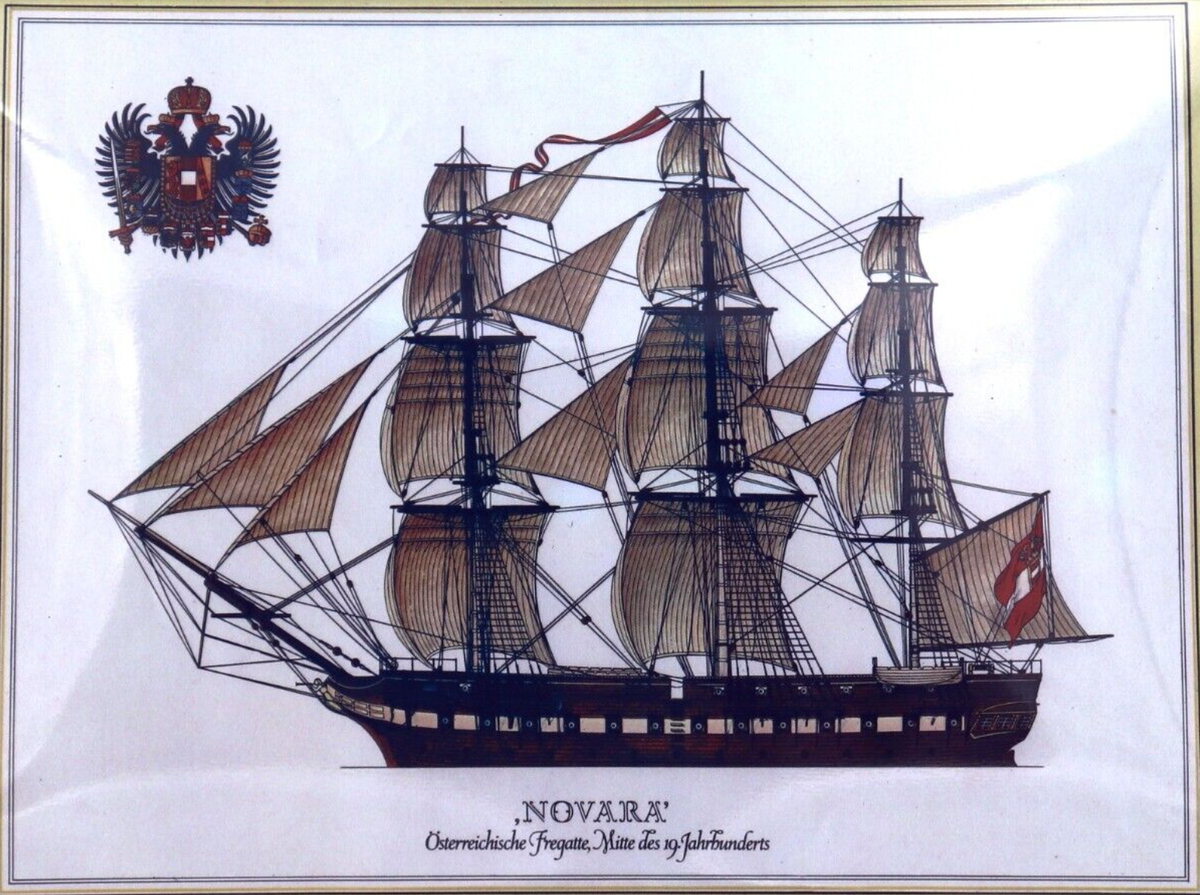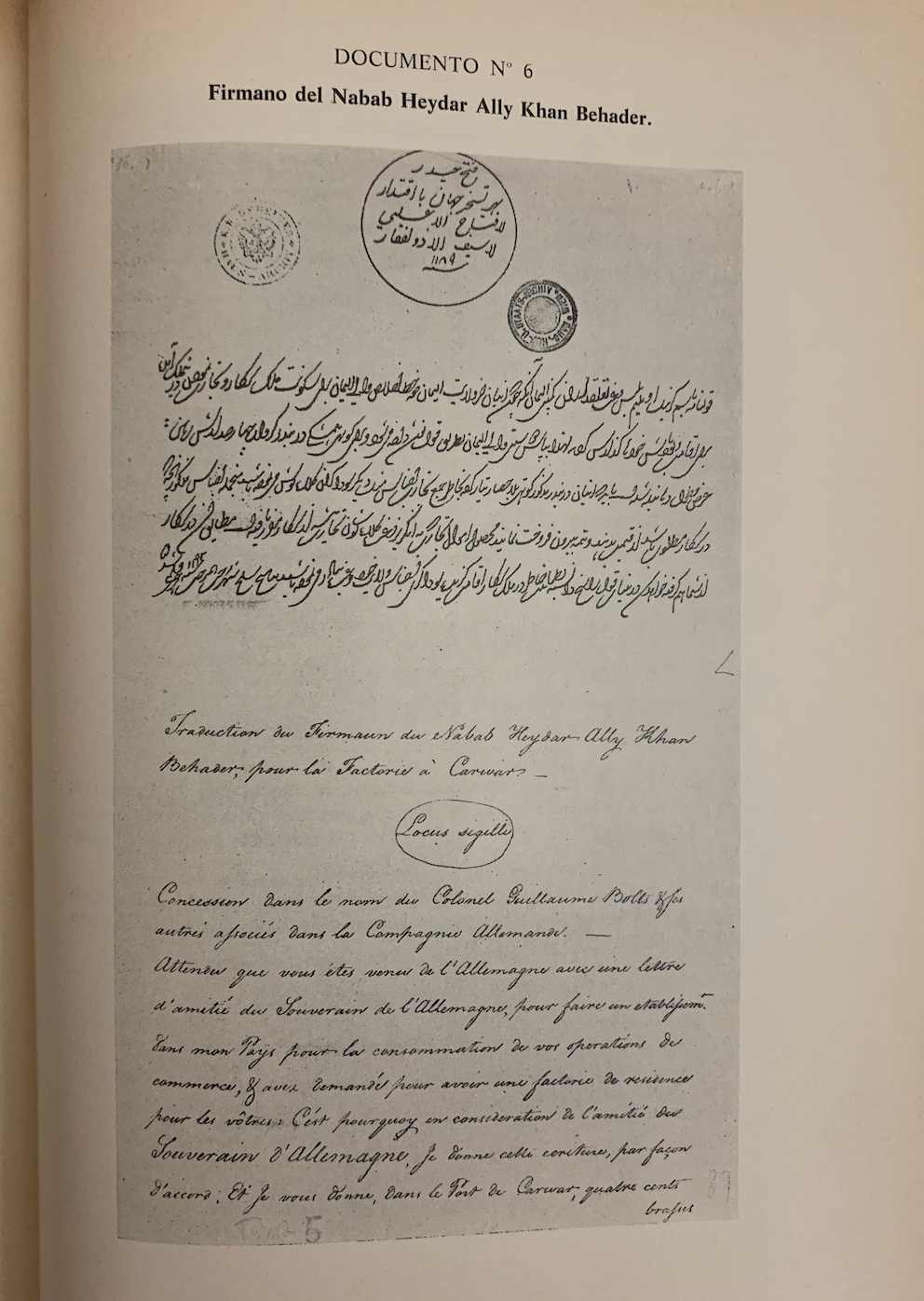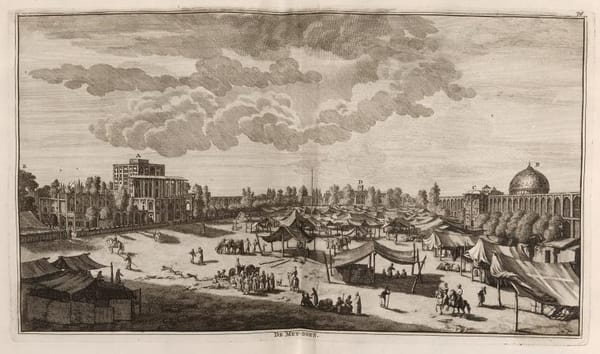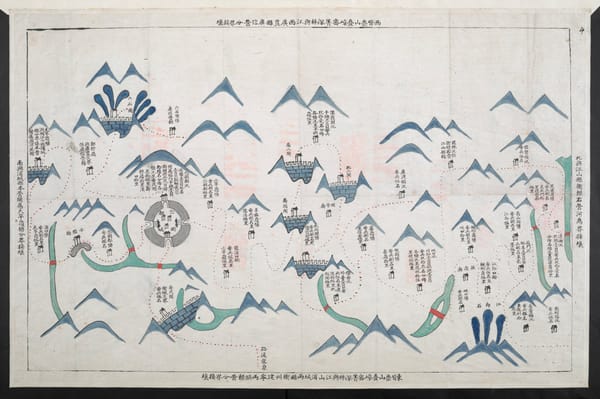Land Grants for a Habsburg Factory in Southern India, c. 1777-1785

Between 1857 and 1859 the Novara, a ship of the Austrian Empire, completed a round-the-world trip. In the official history commissioned after the voyage, the introduction was dedicated to the handful of earlier Habsburg entrepreneurs who had made their way to Asia from the late seventeenth century (Ritter von Scherzer, Reise der oesterreichischen Fregatte Novara, 358; Narrative of the Circumnavigation of the Globe by the Austrian Frigate Novara). Extensive space was allocated in particular to the late eighteenth-century exploits of William Bolts. A merchant entrepreneur of Dutch origin, Bolts had a tumultuous spell as an employee of the East India Company, but his reputation garnered lasting ignominy in his own lifetime by his championing of the short-lived and disastrously-managed Austrian East Indian Company (circa 1775-1785).
While sailing along the coasts of the Indian Ocean Bolts made calls at several ports to secure trading agreements with local authorities, from the Danish inhabitants of the Nicobar islands to the Portuguese settlement at Delagoa Bay in Mozambique. Among the Indian rulers with whom Bolts parleyed was the nawab of Mysore in southern India, Haidar Ali Khan. Through incessant wars with his rivals (including the East India Company and Portuguese in Goa) and astute alliance-making (with the French, among others), Haidar Ali dramatically expanded his domain between the early 1760s and his death in 1782, when his son Tipu Sultan (d. 1799) took over where his father had left off.
As the travelog of the Novara’s journey outlined, in 1777-78 Bolts “purchased from the [nawab]...a number of plots of ground in the vicinity of Mangalore, Carwar, and Balliapatam, the very centre of the pepper trade, and erected a factory at an expense of 28,074 florins (£2800).” (Scherzer, Reise, 358; Scherzer, Narrative, 9-10). A more extensive German-language report comprising commercial statistics written in the wake of the Novara’s circumnavigation, relayed that Bolts earmarked 27,474 florins, 12 kronen for the “Purchase of land, construction of buildings and warehouses, etc,” with the remaining 600 florins reserved for the procurement of a sloop (Schaluppe) for trade with Malabar. The report then added that “Concerning the agreement which Bolts reached with Hyder Aly Khan…no more details are to be found, except for the fact “that no guns are to be used in the factories, and that the dwellings and warehouses are not to have the appearance of fortresses.”” (Karl von Scherzer, “Die Nikobarischen Inseln,” Reise der Österreichen Fregatte Novara....Statistisch-Commercieller Theil, 302). This demand that the Austrian factories remain de-fortified was perhaps an effort by Haidar Ali - ever at loggerheads with fortified European settlements situated on the coasts of southern India - to ensure that the Austrian presence did not transmogrify into yet another European maritime thorn in the side of his terrestrial domain.
The Novara report was unambiguous in its assertion that Bolts purchased these plots from Haidar Ali and that they became Austrian patrimony. Similar conclusions were reached close to seventy-five years before the Novara set sail, in the 1780s, when the European press was abuzz with news of Bolts’ covenant with Haidar Ali. In 1784 the Journal Politique du Bruxelles - with Brussels then still a Habsburg city - asserted that the possessions Haidar Ali “had ceded to the House of Austria in the kingdom of Canara, and the islands of Nicobar, are very well situated for the commerce of Bengal, and China, and Japan, and are rather convenient as an entrepot of East Indies merchandise” (Journal Politique du Bruxelles, No. 49, 4 Décembre 1784, 8). The 1785 mercantile compendium, La parfaite intelligence du commerce, repeated the claim that these were now Austrian possessions handed over by Haidar Ali (“Nouvelles Possessions de la Maison d’Autriche, en Asie,” La parfaite intelligence du commerce, Vol. 1, 169). Finally, contemporary histories of the Habsburg emperor, Joseph II, proclaimed that he had deliberately sought out the friendship of Haidar Ali. The Kaiser was said to have dispatched gifts to the nawab of Mysore as a token of his appreciation for Haidar Ali’s concession of lands around Ballipatnam and Karwar for the creation of Austrian factories and the permission given to Austrian merchants to utilize Mangalore as a trading port (Franz Xaver Huber, Geschichte Josephs II. römischen Kaisers, Königs von Hungarn und Böheim, 53).
Although they never materialized, the Habsburg factories in southern India clarify that the European factories in the Indian Ocean were riven with competing ideas of legal ownership. In those coastal and hinterland contexts where Asian rulers had the upper-hand - which were the majority before the mid-eighteenth-century - a factory built by European merchants was often construed as a “lease.” In his well-known description of the Surat factory from 1689, John Ovington christened none other than the Mughal emperor Aurangzeb as the factory’s “Land-Lord,” adding that the sovereign was “extreme kind and liberal in permitting us to expend the Rent, which is 60l. Yearly, either in Beautifying, Repairing, or in additional Rooms to the House, so that he seldom receives much Rent from us” (John Ovington, A Voyage to Suratt, 389). The instrument for making a lease between an Asian ruler and a European mercantile interest was typically a firman (or analogous genres of Islamicate grants), a decree by a sovereign that bestowed certain rights and privileges to the holder. The records of European commerce in early modern Asia are replete with anxieties about the renewal and maintenance of firmans, especially in times of succession between rulers.
The obvious alternative to a lease was an outright seizure of land by Europeans, the annihilation or subordination of local authorities, and the installation of an outright colonial regime. Conforming neither to the model of the temporary lease or outright expropriation, Bolts' purchase of land for the foundation of a factory may have been something of a novelty. The transaction said much about how Mughal decentralization and the rise of Indian and European successor states had altered the calculus of economic power in the subcontinent by the 1770s. The legal arrangements prevailing in 1680s Surat, then still the preeminent port of the Mughal Empire, were a world away from 1770s Karnataka. Even so, whether Haidar Ali and his lieutenants understood the transaction in the same way as Bolts and the European press is another question entirely.
Thankfully, contrary to the historian of the Novaro's claim that no material exists to detail Bolts' agreement with Haidar Ali, a firman given by Haidar Ali has survived. Written in Persian (on the Hijri date Rajab 1192 or July 1778) and translated into French (in August 1778), the firman mentions Bolts by name and furnishes him with a plot of land in the port of Karwar totaling a breadth of 400 cubits/fathoms (chahār ṣad arsh; quatre cents brasses) "to have there a factory (kothī; Factorie) in perpetuity (hamīshagī; à jamais (ou pereptuelle))." In confirmation of what was stated in the account of the Novara, the firman declared that the factory must be "without fortifications" (bīlā ḥiṣār; sans fortifications) and carry out trade in the same peaceful manner as other European merchants, while paying the relevant dues to the kingdom of Mysore.

A copy of the Persian firman with French translation reproduced in Fulvio Babudieri, Trieste e gli interessi Austriaci in Asia nei Secoli XVIII e XIX (Padova: Cedam, 1966), 129-130.
Even with this dual-language document in hand, it is no easy task to discern how Haidar Ali understood the legal status of the Austrian factory. The best indication is the presence of the term "perpetuity", which in Islamic laws of contract and sales carries a rather specific status. Typically in Islamicate societies, absolute sales, pious endowments, and land leases were governed by rules of perpetuity, but this did not mean that the ruler forfeit all privileges of sovereignty over a site within his domain. The same stipulations probably applied to the plots Haidar Ali allocated to Bolts and the Austrian Company. Consequently, while European observers assumed that this agreement meant that these plots became outright Habsburg possessions, the authorities in Mysore likely adhered to the contrary fiction that these were temporary leases. As this example highlights, as with so many other facets of Indian Ocean commercial life, the legal personality of the European factories was multiform and often downright contradictory.
A potential showdown over the legal status of the sites never came to a head thanks to the implosion of the Austrian East India Company in the mid-1780s and the eventual destruction of the kingdom of Mysore by the East India Company in 1799. When the Novaro visited India and the Nicobar islands in the late 1850s, formal European empire had descended across the length of the Indian Ocean and the political polycentrism intrinsic to the Bolts-Haidar Ali settlement had largely become a figment of the past.
Sources:
Journal Politique du Bruxelles
M. [Malisset d'Hertereau] eds., La parfaite intelligence du commerce, ou se trouvent les connoissainces & les renseignements les plus utiles à diverses classes de citoyens, vol. 1 ([Paris]: n.p, 1785).
Fulvio Babudieri, Trieste e gli interessi Austriaci in Asia nei Secoli XVIII e XIX (Padova: Cedam, 1966).
John Ovington, A Voyage to Suratt, in the Year, 1689: Giving a Large Account of that City, and Its Inhabitants, and of the English Factory (London: Jacob Tonson, 1696), 389
Karl Ritter von Scherzer, Reise der oesterreichischen Fregatte Novara um die Erde: in den Jahren 1857, 1858, 1859 (Wien: K.-K. Hof- und Staatsdrucker in Commission bei K. Gerold, 1861).
ibidem, Reise der Österreichen Fregatte Novara....Statistisch-Commercieller Theil, vol. 1 (Wien: K.-K. Hof- und Staatsdrucker in Commission bei K. Gerold, 1861).
ibidem, Narrative of the circumnavigation of the globe by the Austrian frigate Novara, (Commodore B. von Wullerstorf-Urbair,): undertaken by order of the imperial government, in the years 1857, 1858, & 1859 (London: Saunders, Otley, & Co., 1861).
Franz Xaver Huber, Geschichte Josephs II. römischen Kaisers, Königs von Hungarn und Böheim, vol. 20 (Wien: Mößle, 1790).





